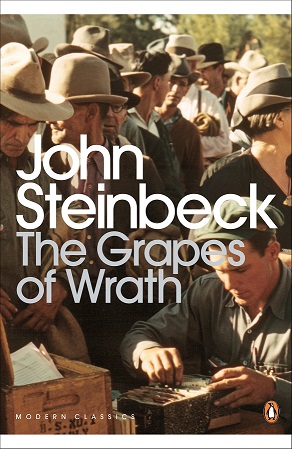Review: The Grapes of Wrath

“What some people find in religion a writer may find in his craft…a kind of breaking through to glory.” —John Steinbeck, in an interview from 1965
Winner of the 1940 Pulitzer Prize for Fiction, Steinbeck’s powerful ode to the working poor is mandatory reading. The reader is given a front seat to the plight of migrant workers during the Dirty Thirties, a time when drought and famine displaced thousands of families and pushed even the most virtuous to the extremes of their humanity.
Starting in the summer of 1930, weather conditions changed for the worse across the Great Plains — a region occupying the middle expanse of the contiguous U.S. marked by flat, relatively arid farmland and temperate climate. Rainfall hit record lows, with the growing season gains in the climatically favorable 1920s insufficient to offset the rapidly swelling shortfall. When drought eventually set in, the windswept grasslands eroded and the topsoil moldered into thin films of dust.
As one of the windiest regions of the country, high-energy winds swept across the Plains, lifting the dusty particulate matter and carrying it as far east as New York City and Washington, D.C. With the breadbasket desiccated and an already depressed economy exacerbated, more than three million Great Plains natives vacated west in search of work and better conditions.
It’s a story that couldn’t have waited any longer to be told. Initially working as a reporter on the abject conditions ripping through the American heartland, Steinbeck quickly became verklempt over the millions of Midwestern vagabonds forced out by the Dust Bowl. During multiple stints in the 1930s he witnessed the hardship firsthand in Visalia and Nipomo, where some five thousand able-bodied families, many from Oklahoma, were “not just hungry, but starving to death.”
Drawing on notes borrowed from the Farm Security Administration, Steinbeck recounts how government assistance was forestalled all down the line by oligarchic interests, in which the feudal-like dispositions of wealthy landowners and corporate farmers reigned wickedly over the lives of millions and ensured the deplorable conditions continued unabated.
The sting to his conscience over the crisis out West grew so sharp that The Grapes of Wrath burst from Steinbeck’s pen in a mere 100 days. It was the culmination of many years of anger, unrest and passive advocacy, a literary opus that sought to throw light on the scourge of social inequality the way that Uncle Tom’s Cabin paved the way for abolition.
Yet Steinbeck’s novel is not a classic solely for its uncompromising portrayal of the era, but for its indefatigable cast that sets down roots in the reader’s mind. The close-knit Joads are a microcosm of the tumult that swept the agricultural belt during the Great Depression, and they come across vibrantly as their sense of dignity, pride and sanity is tested at every turn. This is an unhappy novel with an unhappy ending that all but forces you to admire the unflagging resolve and indomitable spirit of the harried families that trudged across state borders in search of the most basic means of survival. As an embattled generation charges through fantastic adversity, Steinbeck’s dramatis personae stand out as inspiration for us all.
Some have faulted the lyrical structure of the book, which alternates between narrative and meta-exposition, as amounting to tedious filler and interrupting the flow of the story. But this is much more than just a story; operating here are themes of history, of politics, of social structure and of human nature. The symbology of the chapters intervening the Joad plight serves as a means of expressing a national-historical mood through metaphor and helps ground the narrative in its larger context. In Steinbeck’s hands it is an effective tool for digging through to these more open-ended themes and passing them down through the coffers of history.
For newcomers as well as repeat readers I recommend the Penguin Books edition for its scholarly introduction by Robert DeMott. You’ll get a lot of interesting foreground on Steinbeck and the series of events that compelled him to lend a voice to this memorable era in American history.
Note: This review is mirrored over at Goodreads and at Amazon.
Further reading:
- The Dust Bowl and Aftermath (Department of Geosciences, Texas A&M University)
- Dust Bowl (History.com)
- THE DUST BOWL (National Drought Mitigation Center, University of Nebraska)
- Dust Bowl Migration (University of California, Davis)
Feature image via Wikimedia



Comments